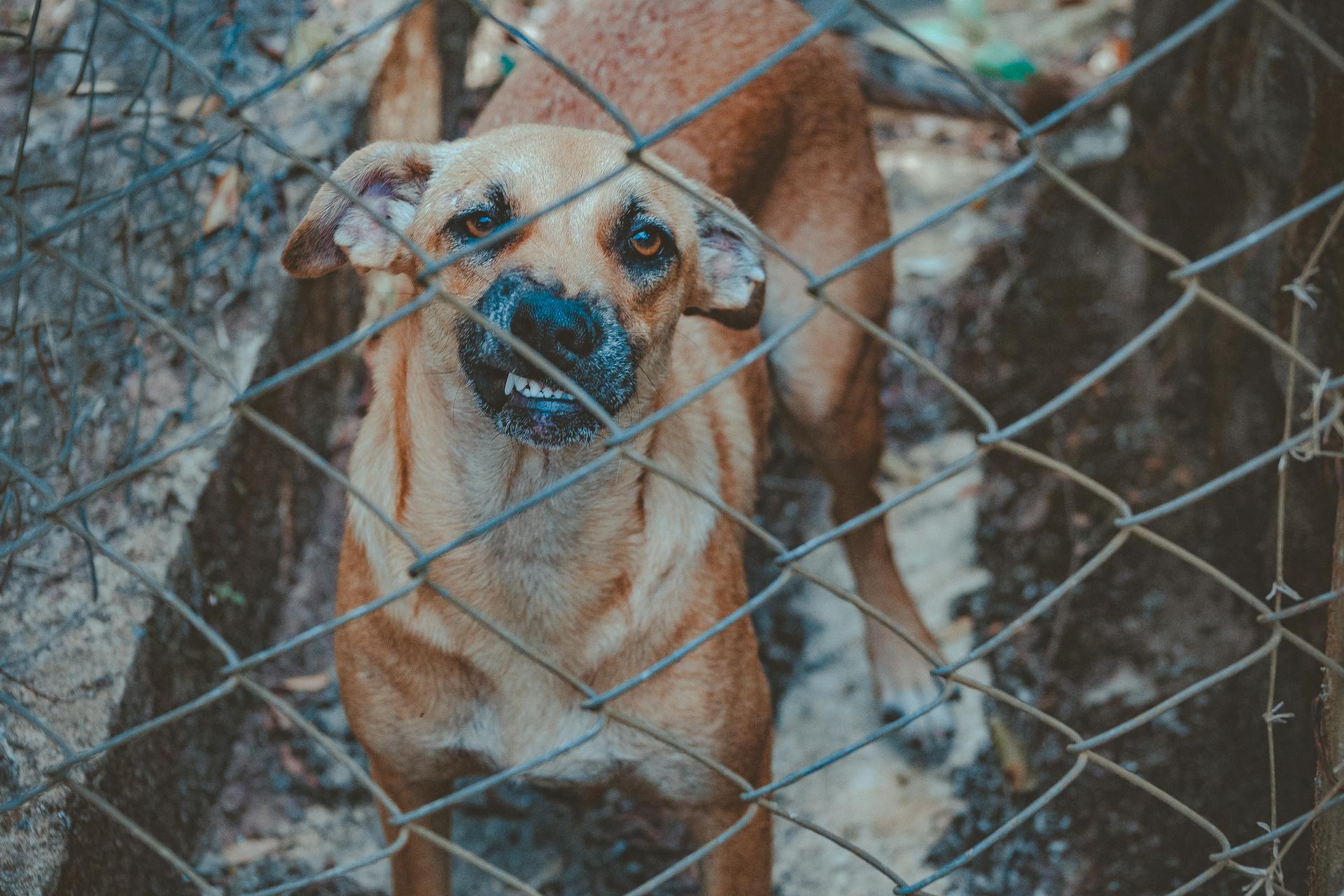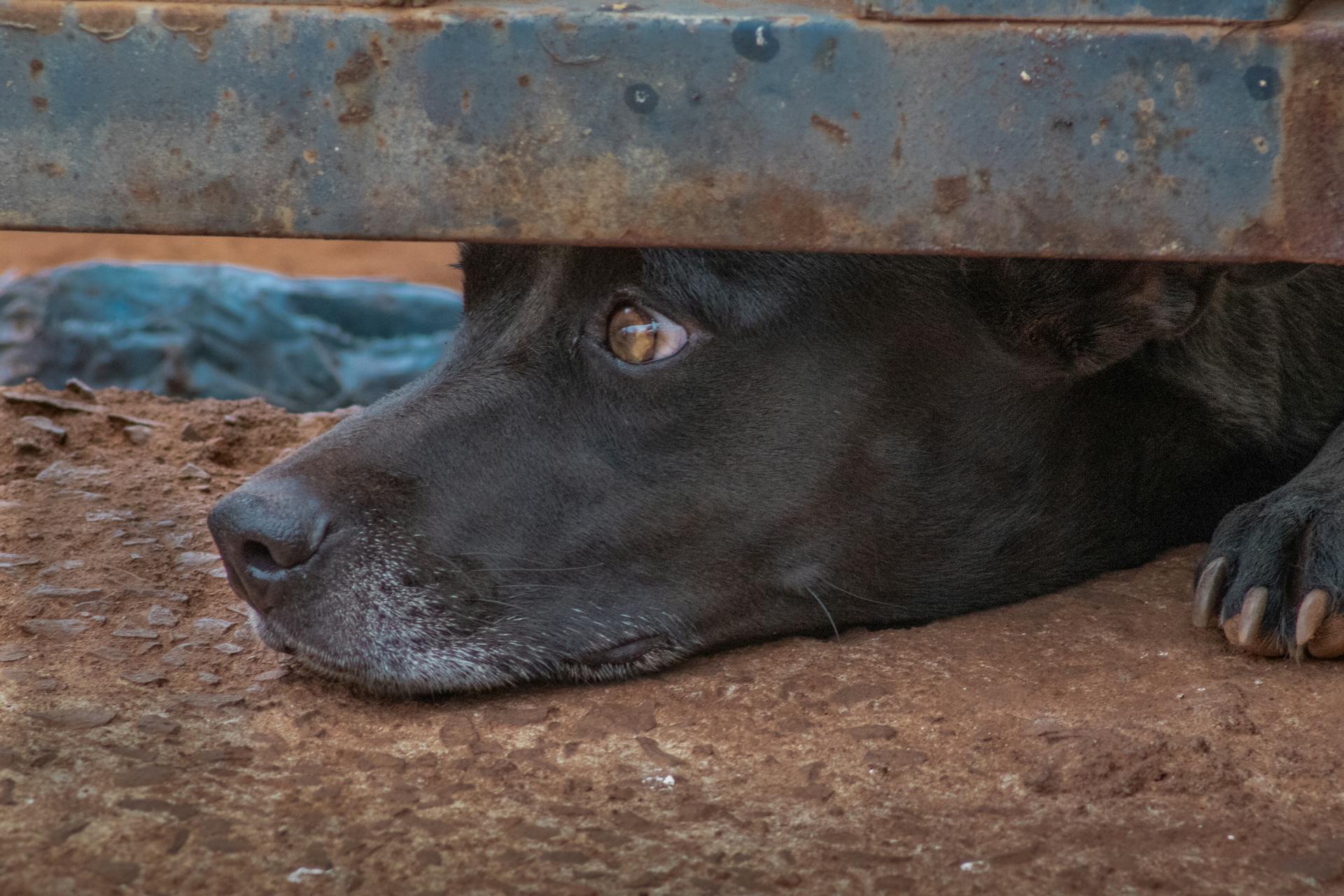
Preventing your dog from getting lost in the first place can make a huge difference. According to studies, microchipping your dog can increase the chances of being reunited by up to 50%.
If your dog does manage to slip out, staying calm and acting quickly is essential. A study found that dogs that are picked up within the first 24 hours of being lost have a much higher chance of being reunited with their owners.
To minimize the risk of your dog getting lost, it's crucial to keep your home secure. Make sure all doors and gates are locked, and consider investing in a dog-proof fence.
Lost Dog Behavior
If your dog is lost, it's essential to start looking for him immediately. Some dogs go into survival mode almost immediately, while others may take weeks or more to revert to this state.
The chances of finding your dog are greater if you find him before survival mode kicks in. This is because, in survival mode, your dog will not respond to familiar cues like his name or favorite toy.
In survival mode, your dog's primal instincts take over, and his primary concerns become food, water, safety, and shelter. He may not even recognize you or respond to familiar commands.
Understanding that your dog is in survival mode can be beneficial in your search. It's not a reflection of your dog's training or intelligence, but rather a natural response to stress and separation from his owner.
Your dog's brain chemistry plays a role in this behavior, specifically the depletion of serotonin, a hormone responsible for short-term memory and sensory perception. This depletion can cause short-term memory loss, making it more challenging to retrieve your dog.
Recovery and Prevention
Preventing your dog from getting lost is key to avoiding the stress and uncertainty that comes with a missing pet. By taking proactive measures, you can ensure your dog stays safe.
There are several resources available that can help you with lost dog behavior, including the Lost Pet Research and Recovery site, which contains a free lost dog search checklist and articles on lost dog behavior. Several pet detectives have also written guides on how to find a lost dog.
To help your pup overcome Lost Dog Syndrome, create a safe and secure environment for them, with a warm, calm, and comfortable space free from potential anxiety triggers. Give them some toys, a blanket, and make sure they get some rest.
Here's an interesting read: Is It Safe to Take Dogs to the Dog Park
Preventing Problems

Creating a safe and secure environment for your pet is crucial when they return home after being lost. This means providing a warm, calm, and comfortable space with no potential anxiety triggers.
To prevent your dog from getting lost in the first place, consider using proactive measures. Several pet detectives have written guides on how to find a lost dog, which can also help you understand how to prevent it from happening.
A free Lost Dog Search Checklist is available on the Lost Pet Research and Recovery site, which can help you prepare for the worst-case scenario. It's always better to be safe than sorry.
If you're concerned about your dog getting lost, make sure to keep a constant eye on them at all times. This can help you identify potential escape routes and prevent them from slipping out unnoticed.
Here are some proactive steps to ensure your dog stays safe:
Remember, every dog is different, so it's essential to understand your pup's nature and temperament to plan the recovery process accordingly.
Preventing Pet Health Issues

To prevent your dog from getting injured or falling ill, it's crucial to keep their identification tags updated, just like you would with your own ID. This way, if your dog gets lost or hurt, you can quickly get in touch with the relevant authorities or medical professionals.
Microchipping your dog is also a must, as it contains all the necessary details to reach out to you in case of an emergency. Make sure to update your microchip details if your contact number changes or you move to a different address.
Keeping your dog on a proper leash whenever you take them outside can prevent them from running away or getting into accidents. Staying with your pet at all times, especially in new or unfamiliar environments, will also help prevent potential health issues.
Remember, the less time your dog spends away from home, the less likely they'll experience the stress and anxiety associated with Missing or Lost Dog Syndrome.
Identifying and Preparing
Lost dogs often exhibit frantic barking as they try to locate their owners, as seen in the case of Max, who barked nonstop for hours after getting lost. This behavior can be a sign of distress and anxiety.
Dogs may also display increased sniffing and exploration behavior as they try to pick up familiar scents, like the smell of their owner's clothing. This is a common behavior in dogs like Bella, who sniffed around her neighborhood for hours after getting lost.
Preparation is key when it comes to preventing and handling lost dog situations. Keeping a recent photo of your dog on hand, as well as a detailed description of their appearance, can be incredibly helpful in the event of a loss.
Home Is Where the Heart
Home is where the heart is, and it's often the first place to check when your dog goes missing. Check your home first, many 'lost' dogs are discovered under beds or shut in a room you hadn’t realised they’d gone in to.
If your dog has slipped out of the house, calling and whistling for them can be an effective way to locate them. Spend at least 15-30 minutes calling and whistling for your dog, and try to sound cheerful. Make some familiar sounds like tapping a fork against their bowl or shaking a box of their favourite treats.
Don't forget to ask your neighbours if they've seen or heard your dog. They may have valuable information to share, or even spotted your dog themselves.
Identification
Having up-to-date identification tags on your dog's collar is a simple yet crucial step in ensuring their safe return if they ever get lost.
Include your name, address, and contact number on the identification tags, as this information can make a significant difference in how quickly your dog is returned.
Always keep the identification tags clean and legible, as a clear and easy-to-read tag is more likely to be noticed by someone who finds your dog.
Understanding the Situation
Dogs with Lost Dog Syndrome become highly suspicious of humans, even their owners, because they believe they have only themselves to rely on for survival.
Their primal instincts take over, and their primary goals become finding food, water, and shelter. Some dogs develop this syndrome almost immediately, while others may take a week or more.
Dogs with Lost Dog Syndrome can be well-trained and obedient, but they may not respond to familiar commands or lures, such as their favorite squeak toy.
For another approach, see: Becoming a Dog Trainer for Service Dogs
Immediate Action
Start looking for your dog immediately, as the chances of finding him voluntarily are greater if you do so before he goes into survival mode. Some dogs can go into survival mode almost immediately, while others take weeks or more.
Begin a search in your neighborhood, checking common hiding spots and asking neighbors if they've seen your pet. Sometimes, dogs don't go far and might be hiding nearby.
If your dog hasn't gone into survival mode, he may approach others and be happily captured and returned home. If he is keeping his distance from people, he is in survival mode and should be left alone to avoid scaring him out of the area.
Curious to learn more? Check out: My Female Dog Is Hiding and Acting Strange
Returning Home
Your dog may seem confused or not obey your commands despite being well-trained after returning home.
This is because they may have developed certain survival instincts while they were on their own, but it's mostly temporary.
Lost dogs may have sore feet due to extensive walking or even cracked and raw paws, so it's essential to take them to a vet to check for any injuries.
Dehydration and significant weight loss are also common issues in missing dogs, so follow the diet recommended by your vet strictly.
Don't let your dog overeat, as it could lead to bloating or other stomach issues.
Your pet is likely exhausted from traveling, so make sure they get adequate rest.
They may have experienced heightened anxiety or panic attacks, so they probably didn't sleep as often as they would have if they were safe at home.
Recommended read: Veteran Dog Treats
Research and Preparation
If you suspect your dog is lost, having a solid plan in place can make a big difference in the search process.
One useful resource is the Lost Pet Research and Recovery site, which offers a free Lost Dog Search Checklist to help you get started.
The checklist includes essential items to gather and information to provide when searching for your dog.
The Lost Pet Research Blog also features articles on lost dog behavior, providing valuable insights into how your dog might behave while lost.
Pet detectives have written guides on how to find a lost dog, sharing their expertise and experience in the field.
Frequently Asked Questions
What is lost dog syndrome?
Lost dog syndrome" is a behavioral condition where a dog, even when reunited with its owner, may flee or resist returning home. This can be a challenging issue to address, requiring patience and gentle guidance to help the dog feel safe and confident in its surroundings.
What are the signs of lost dog?
A lost dog may exhibit signs such as low weight, dirty appearance, hunger, thirst, and fear. If you encounter a dog showing these signs, approach with kindness and patience.
Sources
- https://holidaybarn.com/blog/dog-survival-mode/
- https://www.purina.co.uk/articles/dogs/behaviour/understanding-dogs/what-to-do-if-your-dog-goes-missing
- https://peeva.co/blog/lost-dog-behaviour/
- https://dogtime.com/dog-health/136082-what-is-missing-lost-dog-syndrome
- https://lostpetresearch.com/lost-pet-resources/lost-dog-behavior/
Featured Images: pexels.com


